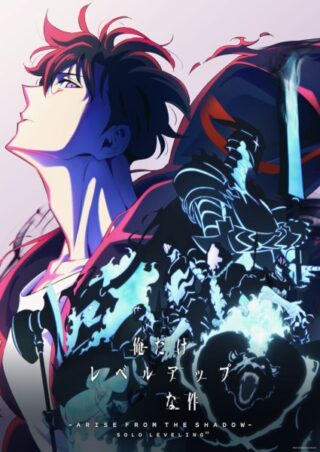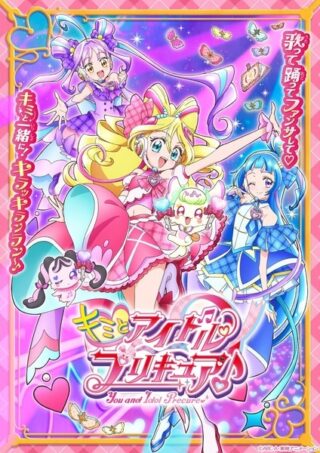Overview:
Kimi to Idol Precure♪ brings a refreshing and dazzling twist to the long-running Precure (Pretty Cure) franchise, blending the magical girl genre with the vibrant world of idols. A dazzling journey filled with music, transformation, and heart, this installment offers a new perspective on what it means to fight evil—not just with fists and magic, but with passion, harmony, and performance. While honoring the traditions of Precure with its themes of friendship and hope, Kimi to Idol Precure♪ sets itself apart through its unique use of idol culture as both aesthetic and narrative core.
From its dazzling character designs and catchy insert songs to emotionally charged storylines that tackle dreams, rivalry, and identity, this season of Precure is not just another magical adventure—it’s a spotlight on personal growth, teamwork, and the emotional power of music. Whether you're a longtime Precure fan or a newcomer drawn in by idol anime, Kimi to Idol Precure♪ offers a glittering stage of excitement and heart.
Setting the Stage – The Idol Academy and the Rise of Precure
The story of Kimi to Idol Precure♪ begins at Harmonia Academy, a prestigious institution where aspiring idols from all over the country come to train, perform, and shine. It’s a place filled with laughter, rivalries, glitter, and dreams—each student striving to find their unique voice and touch the hearts of others. But beneath the dazzling lights lies a creeping darkness. The world is threatened by the sinister group known as Dissonance, who seek to plunge people’s hearts into silence and despair by draining their musical spirit.
Enter the Precure—magical girls chosen to protect the harmony of the world. In this season, their powers are not only tied to courage and love but also to the power of music and performance. By channeling their emotions and expressing their truth through song and dance, they can purify corrupted hearts and fight off the shadowy influence of Dissonance.
The contrast between performance and battle, spotlight and shadow, becomes the thematic heart of the series. The girls aren’t just fighting monsters—they’re defending the right to dream, to express, and to connect.
The Main Cast – Dreams, Doubts, and Stardust
The strength of Kimi to Idol Precure♪ lies in its cast of deeply relatable characters, each embodying a different aspect of idol life—hope, anxiety, perfectionism, creativity—and growing together through hardship and joy. Let’s meet the central heroines.
Hoshizora Riko / Cure Melody is the central protagonist, a bright and earnest girl with a natural talent for singing and an unshakable belief in the power of music. Raised in a small town and new to the academy, Riko starts off unsure if she belongs among the polished and glamorous students of Harmonia. But her genuine kindness, hard work, and radiant voice quickly earn her a place not just on stage, but in the hearts of her peers. As Cure Melody, she symbolizes purity of heart and emotional honesty, and her songs have the unique power to touch even the most wounded souls.
Tachibana Akari / Cure Beat is Riko’s rival-turned-best-friend. With a powerful stage presence and fierce dancing style, Akari is known as the "Queen of Rhythm" at Harmonia Academy. However, her polished exterior hides feelings of pressure, fear of failure, and the weight of high expectations. Her character arc is one of emotional unmasking—learning to trust others, accept imperfection, and sing not just to win, but to connect. As Cure Beat, her magic attacks channel kinetic energy and pulsing rhythms that can shatter darkness.
Minami Shiori / Cure Harmony is the cool and composed pianist of the group. Raised in a prestigious musical family, Shiori initially struggles with her rigid views of art and perfection. She’s technically brilliant but emotionally closed off—until she joins Riko and Akari and discovers that music isn’t just about skill, but soul. As Cure Harmony, her powers blend elegance with control, offering healing and balance to the team.
Together, the trio represents melody, rhythm, and harmony—the three pillars of musical unity. Their personalities contrast beautifully, creating both emotional tension and delightful chemistry. As they grow as performers and friends, so too does their power as Precure.
Idol Culture Meets Magical Girls – Performances That Save the World
One of the most exciting innovations in Kimi to Idol Precure♪ is how it integrates idol culture into the magical girl formula. Instead of simply transforming and fighting, the Precure girls must perform—sing, dance, and radiate emotion—to activate their full potential. This approach makes each battle not just a physical confrontation, but an expressive performance. Every fight feels like a concert, complete with dazzling stages, energetic choreography, and heartfelt lyrics.
Each episode often features a Heart Stage, a magical battlefield that mirrors the emotional conflict of the week’s storyline. If a classmate is struggling with self-doubt, loneliness, or jealousy, the girls must not only fight the monster Dissonance summons from those feelings, but also perform to help them remember joy, confidence, or hope. This adds layers of empathy and emotional storytelling that elevate the show beyond its genre tropes.
The performances aren’t just fluff—they’re integral to the story. Each insert song is carefully tied to character development, emotional milestones, or thematic arcs. Lyrics aren’t background noise; they often carry key narrative insights, and their repetition across episodes becomes a meaningful motif.
Villains of Silence – Dissonance and Emotional Decay
Every great magical girl series needs compelling villains, and Kimi to Idol Precure♪ doesn’t disappoint. The antagonists—collectively known as Dissonance—seek to spread silence, believing that emotions, dreams, and creativity only lead to pain and chaos. Led by the enigmatic Maestro Noire, Dissonance comprises fallen musicians, corrupted idols, and shadowy beings who have given up on connection.
Each villain is uniquely tragic. For example, Legato is a former genius violinist who lost faith in the beauty of sound after a personal tragedy and now seeks to destroy music altogether. Aria is a rival idol who, after being humiliated and cast aside, turns to Dissonance in her thirst for recognition. These villains aren’t evil for the sake of evil—they are reflections of what happens when hope dies, when creativity is silenced, and when people stop believing they have something worth expressing.
The battles against them become emotional showdowns, where the Precure must not only defeat them magically but reach out with words, song, and empathy. Sometimes, it’s a high note—not a punch—that turns the tide.
Themes – Expression, Connection, and Emotional Bravery
Like all Precure series, Kimi to Idol Precure♪ is built around powerful, universal themes. This season in particular focuses on the courage to express oneself and the emotional resilience it takes to be truly seen.
One of the most moving themes is the idea that music is communication. Whether it’s the joy of a duet, the comfort of a lullaby, or the rage of a solo performance, the show continuously highlights how emotions take shape through melody. Music is not just entertainment—it’s how people tell their stories, share pain, and find healing. The girls are not just fighting for applause—they’re fighting for a world where people are allowed to be vulnerable, to dream, and to connect.
Another major theme is emotional bravery. Each character faces inner doubts—whether they’re about talent, self-worth, or pressure. The show emphasizes that bravery doesn’t mean being fearless—it means stepping on stage even when your heart is shaking. This message is deeply resonant not only for kids but for anyone pursuing a passion.
Transformation Sequences and Magical Design
A highlight of Kimi to Idol Precure♪ is the transformation sequences, each filled with sparkle, elegance, and rhythmic flair. Unlike past seasons where transformations are mostly magical, these are full-on performances. Riko spins in her dress while surrounded by music notes, Akari strikes dynamic poses with neon lights and breakbeats, and Shiori is bathed in shimmering piano keys and soft hues.
The costume design blends classic Precure frills with idol fashion—short skirts, glowing accessories, performance headsets, and boots that glitter with each step. The weapons, too, are musically inspired—like Cure Beat’s Rhythm Staff or Cure Harmony’s Clef Bow.
These transformations aren’t just visual spectacles—they show how each girl expresses her identity through music. Over time, as the girls evolve emotionally, their transformations subtly change too, reflecting growth and newfound confidence.
Supporting Cast and World-Building
The world of Kimi to Idol Precure♪ is populated with a rich supporting cast. There’s the charismatic principal of Harmonia Academy who once dreamed of being an idol herself. The classmates each have unique performance styles and subplots—from the shy beatboxer who finds her rhythm, to the diva with stage fright.
There are also production elements like vocal coaches, stage tech crews, and rival schools that add realism to the idol environment. Combined with the magical elements, this layered setting feels alive and immersive.
Even the audience matters. People in the crowd respond emotionally to the performances, and their joy, hope, or sadness influences the outcome of battles. It shows that everyone plays a part in creating harmony.
Climax and Emotional Resolution
As the season approaches its climax, Dissonance launches a full-scale assault on Harmonia, plunging the world into silence. The Precure are faced with their greatest challenge yet—not just defeating Maestro Noire, but reigniting the world’s belief in music and hope. It’s not just about saving the stage—it’s about saving the human heart.
The final episodes are emotionally gripping. Each girl revisits her past, her wounds, and her dreams. They perform not just to win, but to say something real—to the world, to each other, and to themselves. Their final song isn’t a battle cry—it’s a love letter to music, to friendship, and to being true to yourself.
Conclusion – A Song for the Soul
Kimi to Idol Precure♪ isn’t just a magical girl show with idol aesthetics. It’s a beautifully crafted story about expression, emotional honesty, and the transformative power of music. It honors the legacy of Precure while pushing the boundaries with new ideas, heartfelt themes, and unforgettable performances.
In a world where silence often overwhelms us, where people hide their pain or feel unworthy of being heard, this series sings a bold, glittering truth: your voice matters. Your story matters. And when we sing together—when we share our joys and sorrows in harmony—we become powerful enough to change the world.
Kimi to Idol Precure♪ invites us all to step onto the stage of life, take a deep breath, and sing our hearts out. Because somewhere, someone needs to hear your song.
Characters and Voice Actors
Aokaze, Nana
MainTakahashi, Minami
JapaneseSakura, Uta
MainMatsuoka, Misato
JapaneseShigure, Kokoro
MainTakamori, Natsumi
JapaneseChokkirinu
SupportingYahagi, Sayuri
JapaneseCutty
SupportingYamada, Hiroki
JapaneseHibiki, Kaito
SupportingSakuma, Daisuke
JapaneseHigashinaka, Mikoto
SupportingMurakami, Natsumi
JapaneseKomiya, Ema
SupportingMatsui, Akiha
JapaneseMeroron
SupportingHanai, Miharu
JapanesePikarine
SupportingOhara, Sayaka
JapanesePurirun
SupportingNanjou, Yoshino
JapaneseSakura, Kazu
SupportingEgashira, Hiroya
JapaneseSakura, Oto
SupportingKitahara, Sayaka
JapaneseSakura, Hamori
SupportingIida, Yuuko
JapaneseTanaka
SupportingSuwabe, Junichi
JapaneseZakkuri
SupportingSatou, Setsuji
Japanese
Show All
Recomended For You!

E?

E?

E?

E?

E?

E?

E?

E?
